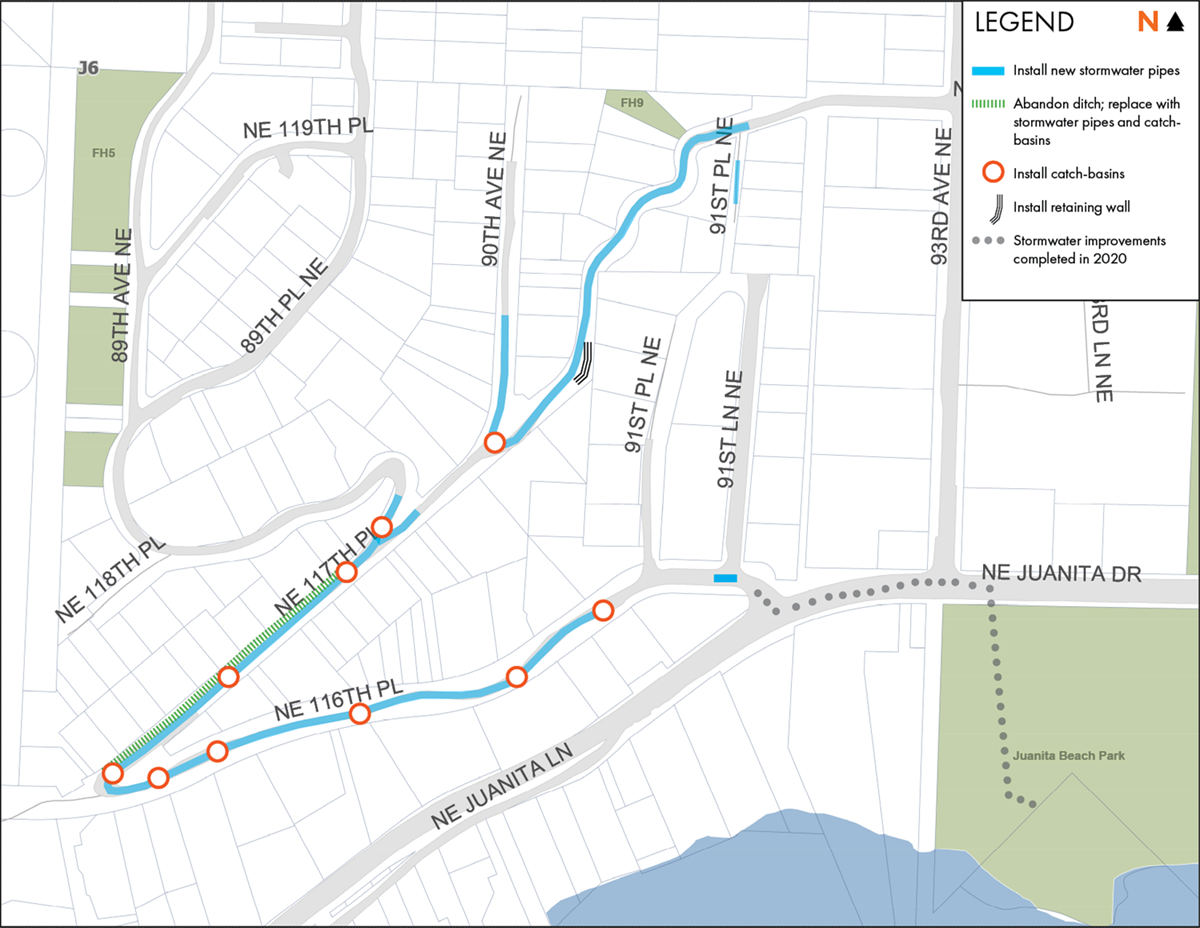- Project typeStormwater mitigation
- Project value$3,161,205
- Project scheduleApril 2024 - fall 2024
- Contractor nameOMA Construction

Kirkland’s Goat Hill stormwater drainage contractor plans to begin work in April on a project that will improve stormwater drainage and slope stability on sections of Goat Hill by completing a variety of tasks aimed at slowing and consolidating stormwater.
The project will abandon an open ditch install along Northeast 117th Place, install 2,500 linear feet of new stormwater pipe along it, Northeast 116th Place and 90th Avenue Northeast. It will also install more than 50 catch-basins and a retaining wall.
To see the locations of the improvements, please refer to the map above(PDF, 259KB).
This capital project is the second of two projects Kirkland planned to reduce flooding potential on Goat Hill.
The City hired OMA Construction in February 2024 to implement the design and plans to complete construction by October 2024.
What’s causing the drainage issues? Isn’t private development contributing to more runoff?
Goat Hill’s drainage issues derive from two primary sources: groundwater and surface water. The groundwater results from a high water table and Goat Hill’s soil-type. The surface water results from roofs, driveways, sidewalks and other impervious surfaces created during house construction before King County began enforcing modern development standards.
How is the City of Kirkland addressing stormwater drainage challenges in Goat Hill?
The City is using responding to these challenges with a variety of development standards and capital projects.
A 2014 study of Goat Hill’s drainage challenges resulted in two capital projects. The first project—which the City completed in fall 2019—increased stormwater capacity on 116th Place Northeast at its intersection with Juanita Drive by installing a stormwater system of pipes, catch-basins and an outfall, from which stormwater now flows into Lake Washington. That project also repaired damaged pavement along 116th Place Northeast.
The second project is the subject of this webpage.
Another part of the solution for Goat Hill’s stormwater relies on development standards. The City, for example, requires each house to collect, convey and treat the stormwater it generates. And under some circumstances, the City can channel superficial groundwater into its stormwater system.
During private development, how can the City ensure that residents have access to their homes and, at the same time, to City streets?
The City ensures residents’ access by regulating developers’ work hours, their traffic control plans, the order of construction and by enforcing development standards.
For example, Kirkland requires pre-construction meetings between developers utility providers and City staff to discuss project challenges, work hours and dates of conflict, such as garbage days.
The City also requires developers to widen adjoining roadway sections to 20 feet before construction; a measure that maximizes roadway space while they build homes.
Can the City just limit the number of building permits on Goat Hill?
The City cannot legally withhold or delay the issuance of a permit if the application for that permit is valid and complete.
How can the City improve the condition of these limited parking areas and regulate them more effectively?
Kirkland’s maintenance division maintains gravel turnouts in the spring. It is planning to increase maintenance to them. Maintenance crews restore damaged sections of pavement in late spring and summer throughout the city and on Goat Hill.
How can the City remedy these visibility challenges?
Kirkland’s most effective tool is to require developers to first widen the road-section in front of the houses they are building.
What is the City’s plan to maintain and improve the roadway’s pavement?
Along with increased maintenance, the City is also exploring the feasibility of a more comprehensive solution. That solution would likely cost between $1.3 and $1.5 million. Construction, alone, would cost $800,000. These figures do not include recent inflationary increases.
The roads’ unique characteristics—their widths, topographies and limited access options—make paving Goat Hill significantly more complicated—and expensive—than paving a typical arterial.